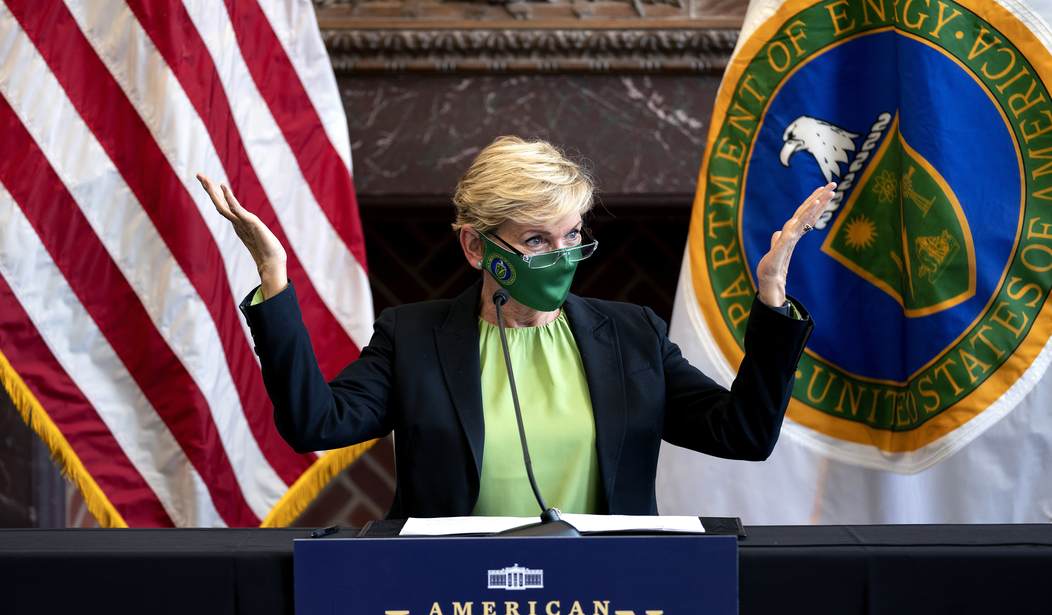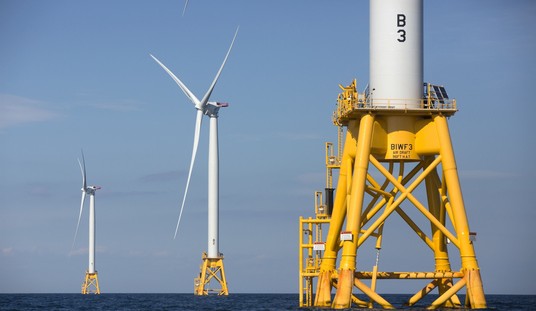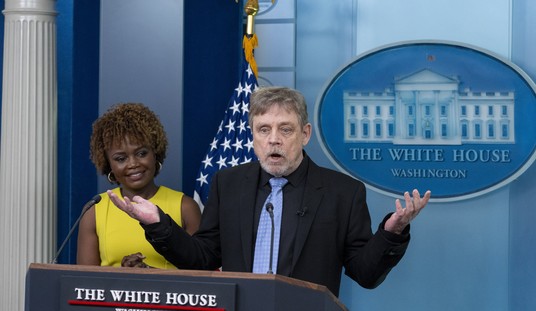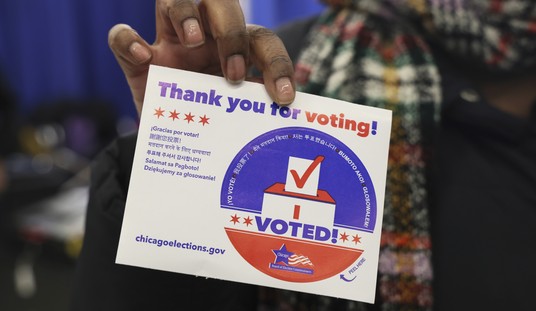Jennifer Granholm, President Biden’s Secretary of Energy, set out to prove that EVs are ready to replace internal combustion engines as America’s primary motor vehicle choice.
It didn’t work out well. At all.
— Scott Lincicome (@scottlincicome) September 10, 2023
NPR’s account of Granholm’s 4-day road trip doesn’t do anything to alleviate the concerns of people whom Granholm set out to persuade.
When Secretary of Energy Jennifer Granholm set out on a four-day electric-vehicle road trip this summer, she knew charging might be a challenge. But she probably didn’t expect anyone to call the cops.
Granholm’s trip through the southeast, from Charlotte, N.C., to Memphis, Tenn., was intended to draw attention to the billions of dollars the White House is pouring into green energy and clean cars. The administration’s ambitious energy agenda, if successful, could significantly cut U.S. emissions and reshape Americans’ lives in fundamental ways, including by putting many more people in electric vehicles.
On town hall stops along her road trip, Granholm made a passionate, optimistic case for this transition. She often put up a photo of New York City in 1900, full of horses and carriages, with a single car. Then another slide: “Thirteen years later, same street. All these cars. Can you spot the horse?”
One horse was in the frame.
“Things are happening fast. You are in the center of it. Imagine how big clean energy industries will be in 13 years,” she told one audience in South Carolina. “How much stronger our economy is going to grow. How many good-paying jobs we’re going to create — and where we are going to lead the world.”
It’s an attractive pitch and reminiscent of every presentation I have ever watched by people who love to plan and persuade, and whose superpower is the ability to completely ignore the limitations of the real world. They spin a great yarn, promise the moon and the stars, and are as realistic and honest as Sam Bankman-Fried.
NPR’s Camila Domonoski rode along with Granholm, presumably to document Granholm’s dramatic trip and her success.
But between stops, Granholm’s entourage at times had to grapple with the limitations of the present. Like when her caravan of EVs — including a luxury Cadillac Lyriq, a hefty Ford F-150 and an affordable Bolt electric utility vehicle — was planning to fast-charge in Grovetown, a suburb of Augusta, Georgia.
Her advance team realized there weren’t going to be enough plugs to go around. One of the station’s four chargers was broken, and others were occupied. So an Energy Department staffer tried parking a nonelectric vehicle by one of those working chargers to reserve a spot for the approaching secretary of energy.
As carbon removal gains traction, economists imagine a new market to save the planet
PLANET MONEY
As carbon removal gains traction, economists imagine a new market to save the planet
That did not go down well: a regular gas-powered car blocking the only free spot for a charger?In fact, a family that was boxed out — on a sweltering day, with a baby in the vehicle — was so upset they decided to get the authorities involved: They called the police.
It turns out that it isn’t illegal for a gas-powered car to block an EV charging station in Georgia, and it is normal enough for an entitled bureaucrat to shove average Americans out of the way for the sake of their grand plans.
Even the ‘great American jobs” pitch is BS–the Biden Administration hates Elon Musk and Tesla so they used Ford and GM cars that are actually far less American in origin than Teslas, which are the most American-made cars in the country, taking the top-four slots in the Cars.com rankings.
Teslas are also the cars that are easiest to charge, with a far more plentiful and reliable charging network. As with everything else Granholm does politics trumped practicality.
If you want to own an electric car you should want to own a Tesla. While hardly a perfect substitute for an ICE vehicle for longer road trips, they are currently the only electric manufacturer that comes close. Elon Musk understood that cars are part of a rarely thought of mobility system that includes convenient refueling options as a necessary component, so he built a network. The parallel system for non-Tesla vehicles is universally regarded as so bad that everybody is switching to Tesla’s standard.
John Ryan, a driver of an electric BMW, pulled up after everything was settled. It was his turn to wait.
“It’s just par for the course,” he shrugged. “They’ll get it together at some point.”
“They” would be the government, the automakers, the charging networks like Electrify America and ChargePoint, and the companies like Walmart, Shell and 7-Eleven that are entering the charging game.
And they are, in fact, desperate to get it together. Carmakers have hundreds of billions of dollars of investment on the line, and they are embracing Tesla’s technology and teaming up with rivals to try to tackle the charging problem. Meanwhile, the U.S. government is pouring billions into a nationwide network of electric chargers, trying to fix the very problem Granholm was encountering.
The primary obstacle to EV adoption is range anxiety, which includes not just the lack of range inherent in the current battery technology (my 18-year-old V8 Lexus LS430 can get about 550 miles on a tank on the highway, and I have hit 600 miles on a tank when I pushed it farther than I should have), but more importantly the difficulty in finding electric filling stations (chargers) and the time it takes to charge up.
Granholm’s trip was a perfect example of why people worry. Most of us don’t have employees driving ICE cars to shoo away the hoi polloi from the charging station we need. Getting stuck waiting at a charger is not something anybody would look forward to.
One reason road trips take so much planning: Some parts of the U.S., including much of the southeast, simply don’t have many high-speed chargers, also called DC fast chargers.
I happen to live on the edge of a charging desert. In my Virginia hometown, there are no DC fast chargers except for a Tesla Supercharger station, which I can’t use … yet. That’s not a problem, since I charge at home. Much more problematic is that if I want to drive through West Virginia, I can access only 11 fast chargers in the entire state. That’s actually progress; three weeks ago, there were only eight.
Where chargers are in short supply, drivers sometimes have to wait — like Granholm’s team did in Grovetown, Georgia. The experience could get even worse as the number of electric vehicles on the road increases in coming years.
“Clearly, we need more high-speed chargers, particularly in the South,” Granholm told me at the end of her trip.
There are 115,000 gas stations in America. I don’t know how many there are in West Virginia, but the number is somewhere north of 11. Given that filling up a tank takes about 5 minutes and charging an electric vehicle isn’t measured in minutes but in units of half hours, a substantial increase in vehicles will mean that each person can expect the wait simply to start charging to skyrocket.
Non-Tesla chargers tend to be both very slow and unreliable. Often they are old technology and the chargers are often broken. Planning a trip has to account not just for finding a charging station, but also for what kind of chargers are there and whether they actually work. And if you run out of charge you can’t call AAA to bring you a can of electricity.
Unlike a lot of conservatives I don’t disdain electric vehicles in principle; I think they can play a role in the transportation future if your needs fit the capabilities the vehicles offer.
As I noted above, my car is an older V8 luxury vehicle, and I love it to death. But I don’t have a large family, don’t need or want a truck, and my driving pattern is a mix of relatively frequent short trips with the occasional long drive to Michigan to see my in-laws.
Others need a minivan. Or a truck. Different vehicles fit different use cases, and I think an electric car would make a great around-town car or even great for day trips. I would love a Tesla for daily driving, and wouldn’t want one as my only car.
But the Granholm/Biden push to electrify everything is like every utopian government-planned project. Think high-speed rail, light rail, urban renewal, public housing, the Space Launch System…I could go on. Less-than-worthless money sinks that waste resources and wind up making things worse.
Tesla has proven that the problem isn’t that electric vehicles aren’t ready for prime time–Tesla and Lexus are tied for overall customer satisfaction.
So it is especially ironic that Granholm chose to exclude Tesla from her dog and pony show. It is the most American manufacturer, the one with the highest satisfaction among owners of electric vehicles, and the most reliable charging network. But is non-union and owned by Elon Musk, so is ineligible for promotion by the Energy Secretary.
Proving that the Biden plan is political and has nothing to do with “good American jobs” or satisfying the needs of Americans. It is a way to push people around and shove money into the pockets of Biden allies.
Typical.








Join the conversation as a VIP Member